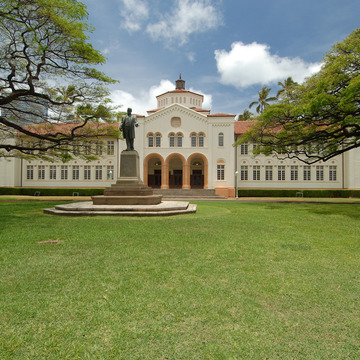Sited on an expansive quadrangular lawn framed by Chinese banyan trees, the red-tile-roofed school forms an elegant green space in the midst of Honolulu. The elaborate entrances and window frames of the five stucco-coated, reinforced-concrete buildings represent some of the state's most ornate Spanish Colonial–style terra-cotta work. Especially memorable are the sculpted owls, symbols of wisdom, perching on the columns that flank the mauka entrances to the original Home Economics and Arts buildings.
The centrally located Marion McCarrell Scott Auditorium, with its large octagonal cupola, was the largest theater in Hawaii upon its completion in 1928, seating 1,114 people. In front of the auditorium stands the eight-foot-high bronze statue of President William McKinley, mounted on a nine-foot-high granite pedestal. Originally located at the Linekona School site (OA92), it was sculpted by Gordon Usborne of Honolulu and cast in one piece using the lost wax technique at the Bertelli studio in New York City in 1911. Hawaii's annexation by the United States transpired, in part, through the efforts of President McKinley.
The Works Progress Administration (WPA)–financed Senior Core Building, constructed in 1939, sits off the corner of the quadrangle. Designed by Ossipoff, it presents a more modern and Island-oriented interpretation of Spanish forms, which complements the original school core. Its cast-stone transom panels by Margarite Blasingame depict Hawaiian motifs and the inset, single-stacked lanai/corridors, which wrap around the makai sides of the pavilion plan, afford protection from trade wind–propelled showers and maximize classroom ventilation. The lanai's terra-cotta-trimmed railings depict taro, breadfruit, and papaya.
McKinley High School played an important role in Hawaii's movement toward a harmonious multicultural community. Miles E. Carey, the school's principal from 1924 to 1948, had been a student of educational philosopher John Dewey at Columbia University, and introduced in 1931 a core curriculum centered on teaching English through an examination of current social problems. This liberal curriculum instilled a sensibility for racial acceptance, independent thinking, and public service, and encouraged the students to participate in the democratic process of government. Also, as part of the program, the students did almost all the landscaping at the school, including the planting of the Chinese banyans. Offering a level of education previously available only at private schools, McKinley produced many outstanding graduates including Governor George Ariyoshi, U.S. senators Hiram Fong and Daniel Inouye, the Reverend Abraham Akaka, financier Chinn Ho, and Melvin Pang. The Hawaii Department of Education undertook a fifteen-year phased rehabilitation of these buildings, which commenced under the direction of architect Leon Noe and concluded with the rejuvenation of the Marion McCarrell Scott Auditorium in 1998, following the design of architect Peter Hsi.















